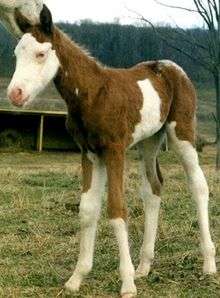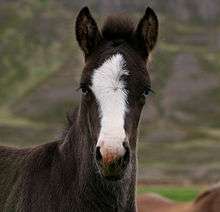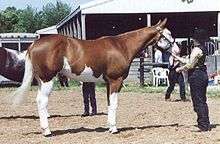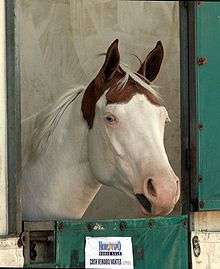Splashed white

Splashed white or splash is a horse coat color pattern in the "overo" family of spotting patterns that produces pink-skinned, white markings. Many splashed whites have very modest markings, while others have the distinctive "dipped in white paint" pattern. Blue eyes are a hallmark of the pattern, and splash may account for otherwise "solid" blue-eyed horses. Splashed white occurs in a variety of geographically divergent breeds, from Morgans in North America to Kathiawari horses in India. The splashed white pattern is also associated with congenital deafness, though most splashed whites have normal hearing. There now exists a DNA test for three forms of splashed white, and there is speculation that the SW-2 and SW-3 alleles may be an embryonic lethal when homozygous.[1]
Characteristics
The splashed white pattern is characterized by the appearance of having been dipped, feet-first, into white paint. Blue eyes are common, but not universal.[2][3][4][5][6] The margins of the white markings are crisp, smooth, blocky, and well-defined.[2][6] The head and legs are white, and the tail is often white or white-tipped.[2][5][6] The underside of the body is white, and a connected white patch often spreads smoothly up either side of the thorax.[6] On its own, the splashed white pattern is seldom responsible for white markings that reach the topline, and so it has been categorized as one of the "overo" patterns by Paint horse and Pinto horse registries.[3]

As sabino-type markings also originate on the underside, some splashed whites can be mistaken for cleanly marked sabinos.[2] Both patterns can be present on the same horse, but splashed white markings are crisp and blocky, and horizontally distributed. In particular, the face markings of splashed whites are straight-edged and bottom heavy, whereas those of sabinos are often tapering or feathered, and often vertical in orientation. The presence of additional white patterning genes can intensify the amount or obscure the characteristics of splashed white markings.[4][5] There is some association between splashed white and deafness in horses that are very white, but more research is needed to determine how this occurs.[4] White extending onto the ears is hypothesized to correlate to deafness. SW-1 has been found in homozygous form, but based on studies in mice, it is possible that SW-2 and SW-3 are homozygous lethals.[4]
Minimal splashed whites
Breed registries for which minimum or maximum white markings are a factor in registration have created imaginary lines to simplify the selection process:
- From the ear, to the eye, to the corner of the mouth, to the chin groove,
- the knee on the foreleg, and
- the hock on the hindleg.

White markings extending past these lines are considered "pinto", "paint" or "colored" while white markings which do not cross these lines are not considered to suggest these traits. However, horses without "excessive white markings" can still have the potential to produce "high white" or distinctly spotted offspring. Splashed white horses have produced generations of "solid" horses, followed by an errant, classically marked splashed white. Discretely marked splashed whites are responsible for some families of cropout American Quarter Horses.[3][4]
The minimal expression of the splashed white pattern can include few or no white markings at all. When only minimal markings are present, other qualities can belie splashed white. Stars and snips may lopsided, off-center, or otherwise strangely placed. Blazes are usually blocky or straight-edged, and bottom-heavy. Splashed white blazes may also be crooked or skewed to one side.[5] Sabinos with a bold blaze almost invariably have white on the lip or chin, and this is not the case for the facial white of a minimally marked splash; the upper lip typically remains colored.[5][7] Leg markings in a minimally marked splashed white range from hind coronets to high-whites on all four, or marked hindlegs and unmarked forelegs. While sabino leg markings are often tapering with distal patches, the leg markings on a splashed white usually have crisp borders.[3]
The most reliable identifier of the splashed white pattern is one or more blue, or parti-colored eyes.[2][3][5]
Inheritance and prevalence

DNA tests exist for three forms of splashed white, labeled SW-1, SW-2 and SW-3. SW-1 is thought have originated hundreds of years ago and today has been identified in the American Quarter Horse, American Paint Horse, Icelandic horse, Miniature horse, Morgan horse, Shetland pony and Trakehner. SW-2 and SW-3 appear at present to be confined to certain lines of Quarter horses and Paints, with SW-3 being particularly rare.[1][4][8] A fourth allele of splash, informally called "Macchiato", produced by the gene MITF:p.N310S has only been found in a single Franche-Montagne horse, probably a spontaneous mutation, and that individual was sterile.[4][9]
The genetic mutations responsible for splashed white are two found at MITF and one at PAX3. SW-1 is the MITFprom1 mutation, the most prevalent. It appears to be several hundred years old and predates the development of modern breeds. SW-2 is a PAX3 mutation (PAX3C70Y) traced to a single Quarter Horse mare foaled in 1987 and is believed to be a spontaneous mutation beginning with that horse. SW-3, the MITFC280Sfs*20 mutation, has been seen in Quarter Horses but is very rare. Some horses of Quarter Horse lineage carry more than one splash mutation.[4][9]
The splashed white pattern was first studied in Finnish Drafts and Welsh ponies by Klemola in 1933.[10] Klemola's multiple studies on the topic have since been largely discredited, his text describing to detail a pattern now recognised as sabino, and his illustrations featuring horses that according to modern knowledge would be a mixture of splashed whites, tobianos, sabinos, and combinations of multiple spotting factors.[11] Originally believed to be very rare outside of Europe, splash is turning out to be more common than previously thought, possibly due to the pattern's tendency to masquerade as modest markings. For example, minimally marked splashed whites have been responsible for cropouts among American Quarter Horses.[3]
Since the original study, SW-1 has been confirmed in the Finnhorse by genetic testing.[12] In addition to breeds identified as carrying the SW-1, -2 or -3 alleles, color patterns described as splashed white but not yet verified via genetic testing have also been identified in American Saddlebreds, Shire horse, Clydesdales, and the Irish Tinker or Gypsy horse.[3][4][5]
There may be additional forms not yet mapped. However studies suggest that it is not part of the linkage group that includes roan and tobiano.[2] The KIT gene is not thought to be a candidate gene for splashed white. Preliminary studies from the early part of the 20th century suggested that splashed white was the result of a recessive gene, however this is no longer believed to be the case.[3] It is more likely that many splashed whites go unidentified, whether because their markings are too minimal to register as "pinto" with breeders, confusion with sabino, or the confounding effect of multiple white spotting patterns.[3][5] It seems therefore more likely that splashed white is the result of an incomplete dominant gene, with homozygotes exhibiting more extensive white than heterozygotes.[4] Just as the presence of additional white patterning genes can increase the amount of white, other genes may be responsible for restricting the expression of splash.[5]
In addition, other patterns have a similar look: in particular, some forms of sabino and splash may be confused with each other, or the two patterns may exist in the same horse.[3] In the Gypsy horse, the pattern called "blagdon" is described as "a solid colour with white "splashed" up from underneath."[13] The genetic mechanisms behind certain traits, such as blue eyes in a few Arabian horses with otherwise minimal markings, have yet to be identified, though there is speculation that splash genes could be involved.[14]

Health concerns
It is possible that the SW-2 and SW-3 alleles might produce non-viable embryos if homozygous. At present, this cannot be ruled in or out, but mating of two horses that carry SW-2 or -3 is discouraged. Testing for SW-1 has identified individuals who are homozygous for this allele, thus SW-1 probably does not have potential lethal characteristics.[1]
Some horses with the splashed white pattern have been shown to have congenital deafness, though many or most have normal hearing.[3][7][15] This type of deafness is probably similar to instances of deafness in white or piebald, blue-eyed examples in other species. In white-coated cats and dogs with deafness, an absence of melanocytes in the inner ear leads to death of the hair cells, which are necessary for perceiving sound.[15] The presence of pigment around the outside of the ears - which most splash horses have - does not prove the presence of that necessary pigment in the inner ear. There must be pigment inside the inner ear to prevent this problem.[1] Domestic horses often cope well with deafness, and deaf horses may go undiagnosed. Some deaf horses are more skittish than normal, while others are distinctly calmer. Deafness in horses can be diagnosed by brainstem auditory evoked potential (BAEP), which is minimally invasive and requires no sedation and minimal restraint.[15] While blue eyes and a white face are often associated with deafness in other species, apron-faced, non-splash horses are not known to be deaf. Nor is the presence of one blue, one normal eye indicative of unilateral deafness. The case horse in Hardland's 2006 case study had one blue eye, while the other was parti-colored, but the horse was bilaterally deaf.[15]
See also
| Wikimedia Commons has media related to Splashed white horses. |
References
- 1 2 3 4 Splashed White Overo (SW-1, SW-2, SW-3)
- 1 2 3 4 5 6 Brooks, S. Studies of genetic variation at the KIT locus and white spotting patterns in the horse. Ph.D. dissertation, University of Kentucky, 2006.
- 1 2 3 4 5 6 7 8 9 10 11 "Splashed white". Genetic Equation. American Paint Horse Association.
- 1 2 3 4 5 6 7 8 9 10 Bailey, Ernest Frank; Brooks, Samantha A. (2013). Horse Genetics. CABI. pp. 73–76. ISBN 9781780643298. Retrieved 7 December 2014.
- 1 2 3 4 5 6 7 8 9 Laura Behning. "Splashed White". Morgan Colors. Retrieved 2009-01-10.
- 1 2 3 4 Vrotsos, Paul D.; Elizabeth M. Santschi; James R. Mickelson (2001). "The Impact of the Mutation Causing Overo Lethal White Syndrome on White Patterning in Horses" (PDF). AAEP Proceedings. American Association of Equine Practitioners. 47: 385–391.
- 1 2 Dan Phillip Sponenberg (2003). "5 Patterns Characterized by Patches of White". Equine Color Genetics (2 ed.). Blackwell Publishing. pp. 85–6. ISBN 0-8138-0759-X.
- ↑ "Splashed-Whte". Veterinary Genetics Laboratory. University of California-Davis. Retrieved 7 December 2014.
- 1 2 Hauswirth, Regula; Haase, Bianca; et al. (April 12, 2012). "Mutations in MITF and PAX3 Cause "Splashed White" and Other White Spotting Phenotypes in Horses". PLOS Genetics. doi:10.1371/journal.pgen.1002653.
- ↑ Klemola, V (1933). "The "pied" and "splashed white" patterns in horses and ponies". Journal of Heredity. 24: 65–69.
- ↑ Viitanen, Johanna (2007). Hevosen värit [Equine Colors] (in Finnish). Läyliäinen: Vudeka. pp. 110–111. ISBN 978-952-99464-8-8.
- ↑ Alerini, Leena: Uusia värihevosia, uusia testiohjeita, 27.6.2013
- ↑ "Gypsy Vanner Breed Standard" (pdf). Gypsy Vanner Horse Society [GVHS]. Retrieved 2013-02-28.
- ↑ "Should dominant white be considered as sabino white?". Horsegenetics.com. Retrieved 27 December 2014.
- 1 2 3 4 Harland, Malte M.; Allison J. Stewart; Arvle E. Marshall; Ellen B. Belknap (2006). "Diagnosis of deafness in a horse by brainstem auditory evoked potential". Canadian Veterinary Journal. 47: 151–4.
External links
- Deaf Horse Association Official Deaf Horse Association's webpage
